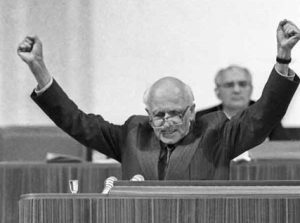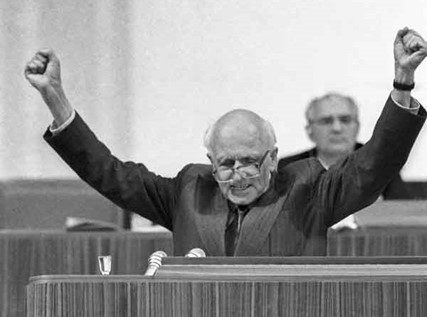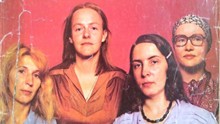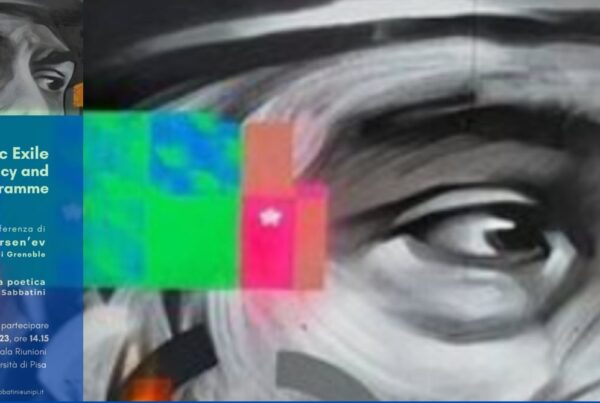Moscow, 1921–Moscow, 1989

Sakharov during a speech to the Duma. Source: https://www.abbanews.eu/gusti-e-cultura/andrej-sacharov/
Andrei Dmitrievich Sakharov (1921-1989) was a Soviet physicist and human rights activist. As an academic he made a major contribution to the development of the hydrogen bomb. As an activist he was committed to defending civil rights, promoting various national and international campaigns on behalf of Soviet dissidents. In 1975 he won the Nobel Peace Prize.
Sakharov was born into a family of the Russian intelligentsia. He spent the first years of his life studying at home, under his father’s guidance, and did not start attending school until he was 12 years old, showing an early aptitude for learning. In 1938, he enrolled in the physics faculty of Moscow State University (MGU) and graduated in 1942 with top marks. He continued his studies in Ashkabad, in present-day Turkmenistan, where he had been evacuated with a group of scientists (cf. Marciante 2020) in 1941. Shortly afterwards, however, he interrupted his studies and went to work in a munitions factory in the Russian city of Ulyanovsk on the Volga, where he met Klavdia Alekseeevna Vikhareva, who became his wife in 1943 and with whom he had three children: Tat’iana, Liubov and Dmitrii.
At the end of the war, he decided to resume his studies and enrolled at the Lebedev Institute of Physics in Moscow (FIAN), where he obtained his PhD in 1947. He then turned his attention to applied astrophysics and nuclear fusion, taking part in the testing of the first hydrogen bomb in the Soviet nuclear programme (cf. Marciante 2020). Sakharov’s contribution to nuclear research was notable, as he also initiated – together with Igor Tamm – a controlled thermonuclear fusion project, TOKAMAK, developing a technology that is now considered among the most promising for producing fusion reactors without the risk of fission (cf. Bonner 2005: 15).
In 1953, Sakharov was one of the youngest scientists to become a member of the Soviet Academy of Sciences. He worked on the Soviet atomic project for twenty years and was awarded the title of ‘hero of socialist work’ three times (1953, 1956, 1962), as well as being awarded the Stalin Prize in 1953 and the Lenin Prize in 1956 (cf. Marciante 2020).
Doubts about the regime began to trouble Sakharov during the years when Nikita Chrushchëv was General Secretary of the CPSU (1953-1964). His first open expressions of dissent date to 1961, when he wrote a letter to the general secretary criticising the decision to resume Soviet nuclear testing (cf. Sakharov 1996: 299-303). In 1964 Sakharov denounced the theories of the agronomist and biologist T. Lysenko at a conference of the Soviet Academy of Sciences (cf. Sakharov 1996: 328-329), after which he met the biologist Zhores Medvedev, who was then writing a book entitled Vzlët i padenie Lysenko (Rise and Fall of Lysenko), later circulated in samizdat in the USSR (cf. Sakharov 1996: 330). The year 1966 marked a turning point: thanks to a meeting with the historian Roy Medvedev, Zhores’s twin brother, Sakharov was introduced into circles of dissenters in Moscow, first becoming interested in reading samizdat manuscripts – such as Roy Medvedev’s essay on Stalin and Evgeniia Ginzburg’s work Krutoi marshrut (Journey into the Whirlwind) – and then taking concrete action (cf. Sakharov 1996: 375-377). In the same year Sakharov signed a number of important petitions, including a letter of protest addressed to Leonid Brezhnev against Stalin’s rehabilitation – Pis’mo 25-ti deiatelei sovetskoi nauki, literatury i iskusstva L. I. Brezhnevu protiv reabilitatsii I. V. V. Stalin (Letter from 25 representatives of Soviet science, literature and art to L. I. Brezhnev against the rehabilitation of I. V. Stalin) – (cf. Sakharov 1996: 369-371). He also took a stand against the introduction of Law 190-1 in the Criminal Code, which made the dissemination of slanderous news discrediting the Soviet regime punishable. The Law was intended as a tool to inflict harsher penalties on dissidents engaged in the clandestine dissemination of material via the samizdat. Sakharova sent a personal telegram to the President of the Presidium of the Supreme Soviet of the RSFSR Iasnov (cf. Sakharov 1996: 372-375) and on 5 December took part in the second miting glasnosti (transparency rally) held in Pushkin Square on the day of the celebration of the Soviet Constitution (cf. Sakharov 1996: 377-378).
In 1968, Sakharov circulated in samizdat his essay Razmyshleniia o progresse, mirnom sosushchestovanii i intellektual’noi svobode (Reflections on progress, peaceful coexistence and intellectual freedom) (cf. Sakharov 1968). The scope of this writing was international; his reflections were permeated by the idea that no country could solve its problems without considering universal questions. Sakharov’s essay soon spread beyond the borders of the USSR and was published abroad in tamizdat. The scientist saw intellectual freedom as a prerequisite for prosperous development. His ideal did not envisage the victory of communism throughout the world: he declared himself to be a proud advocate of the convergence of the positions of socialism and capitalism, which he believed could lead to the creation of a global, open and pluralistic society. Sakharov probably finished writing his Reflections by April 1968, which began to circulate clandestinely in the USSR among dissidents, and on 6th July the essay was published in the Dutch newspaper “Het Porool” and in the “New York Times”. After this, various Western publishers printed the work which achieved worldwide success with 18 million copies. Sakharov’s name became unequivocally associated with Soviet dissent but his popularity in the West was mirrored by persecution at home and he was soon prevented from practising his profession.
Sakharov, however, did not stop campaigning for human rights and in 1970, together with Valerii Chalidze and Andrej Tvërdokhlebov, founded the Komitet prav cheloveka v SSSR (Committee for Human Rights in the USSR) – whose members included A. Esenin-Vol’pin, S. Kallistratova and E. Bonner, who later became Sakharov’s wife. The committee became the first non-governmental Soviet organisation to obtain international recognition and cooperated with the International League of Human Rights and the International Institute of Human Rights. By statute, the Committee’s activities included monitoring and reporting on human rights violations, which they intended to carry out in the open, with the aim of showing the government that their actions were legitimate and in accordance with the Soviet Constitution. Despite its good intentions, the Committee did not succeed: the KGB vigorously opposed its actions and quickly arrested all its members. The regime’s harsh reaction did not dampen Sakharov’s commitment to civil rights, and he continued to work uninterruptedly for another ten years. During this time he signed dozens of documents in which he made public the names of hundreds of people persecuted for their political and religious beliefs. Among Sakharov’s demands were the abolition of the death penalty, the proclamation of an amnesty for all political prisoners and the rehabilitation of deported peoples.
As his public standing and international support grew, the regime placed him under close surveillance and, after numerous denunciations – often by colleagues at the Academy of Sciences – and even numerous letters of protest against his activities sent to newspapers by ‘ordinary citizens’, in 1973 he became the object of a full-blown smear campaign.
In 1975 Sakharov was awarded the Nobel Peace Prize for his activism and for having denounced the nuclear arms race. The Soviet authorities did not allow Sakharov to leave the country and his wife Elena Bonner, who was in Italy at the time, went to Oslo in his place. She read her husband’s lectio magistralis at the official ceremony entitled Mir. Progress. Prava cheloveka (Peace. Progress. Human Rights): “Peace, progress, human rights: these three objectives are inextricably linked and none of them can be achieved by neglecting the others… International trust, mutual understanding, disarmament and international security are unthinkable without open societies, freedom of information, freedom of thought, transparency, freedom to travel and the possibility of choosing one’s country of residence… Freedom of thought, together with other civil liberties, is the basis of scientific and technological progress, the guarantee against the use of its achievements to the detriment of mankind, and, precisely for this reason, is the main foundation of economic and social progress, as well as the political guarantee of the possibility of effectively protecting social rights” (Sakharov 1975).
Also in 1975, Sakharov published the essay O Strane i Mire (My Country and the World), in which he illustrated the dangers of détente and denounced the repressions perpetrated in the USSR. In 1976, at one of the many press conferences Sakharov convened in his flat, Professor Iu. Orlov announced the creation of the Moscow Helsinki Group.
In 1980 Sakharov protested against the Russian invasion of Afghanistan (cf. Sakharov 1980), calling on foreign powers to boycott the USSR as it prepared to host the Olympic Games. However, despite his opposition to the regime, given his international reputation, the Politburo did not dare to arrest him and, in 1980, sent him into exile in the city of Gor’kii – today’s Nizhnii Novgorod, which, at the time, could not be visited by foreigners – to limit his contacts with foreign countries. Despite these restrictions, the physicist did not stop his civil rights campaigns and sent a number of articles and statements to the West via his wife Elena Bonner. In 1984, his wife was also deprived of her freedom, and Sakharov went on hunger strike several times to demand that Elena Bonner be allowed to travel abroad for heart surgery.
When Mikhail Gorbachëv took over as head of the secretariat of the Communist Party and perestroika began, Sakharov was allowed to return to Moscow (1986). In 1987, Soviet periodicals resumed publishing his articles and in 1989 he was one of the founders of the Memorial Association, of which he was elected honorary president.
In the same year, he was elected leader of the Democratic Opposition Party. In this role, he began a parliamentary offensive for the abolition of Article 6 of the Soviet Constitution which guaranteed the dominance of the CPSU. He was elected a member of the Constitutional Commission of Congress and presented the draft of a new Soviet Constitution (cf. Sakharov 1989). On 14 December 1989 he died of a heart attack. The Sakharov Centre was founded in the Russian capital. It preserves part of his archive, houses a museum on Soviet political repression and a library specialising in the Gulag, repression, the struggle for human rights and clandestine Soviet publications.
In 1988, the Parliament of the European Union established the Sakharov Prize for Defenders of Human Rights, the first recipients of which were Nelson Mandela and Anatolii Marchenko. In 2004, with the approval of Elena Bonner, a Sakharov Prize for Journalism was founded for Russian journalists who denounce abuses and violations of human rights in Russia: among the journalists who have won this prize is Anna Politkovskaia.
Federico Ionata
[30th June 2021]
Translation by Iris Karafillidis
This article was produced as a result of the seminar “Civil Rights Movement in the USSR”, held by Ilaria Sicari (Course of Russian Literature, Master’s Degree in Euro-American Languages and Literatures, University of Florence, a.y. 2019-2020).
Bibliography
- Alekseeva L., Istoriia pravozasshchitnogo dvizenija v Rossii, Moskovskaia Khel’sinskaia Gruppa, Moskva 2016.
- Amnesty International. Prisoners of conscience in the USSR: Their treatment and conditions, Amnesty international Publications, London 1975.
- Artemova A., Rar L., Slavinskii M., Kazminye sumasshestviem, Possev, Francoforte 1971, https://vtoraya-literatura.com/pdf/kaznimye_sumasshestviem_1971_text.pdf, online (last accessed: 30/06/2021).
- Caccamo D., Andrej Dmitrevič Sacharov, Enciclopedia Treccani, http://www.treccani.it/enciclopedia/andrej-dmitrievic-sacharov/, online (ultimo accesso: 30/06/2021).
- Cochran T., Norris R., Andrey Sakharov. Soviet physicist and dissident, Britannica, https://www.britannica.com/biography/Andrey-Sakharov, online (last accessed: 30/06/2021).
- De Luca S., Il mio paese e il mondo. Il pensiero di Andrej Sacharov, “InStoria”, 10, 2006, http://www.instoria.it/home/andreij_sacharov.htm, online (last accessed: 30/06/2021).
- Garywo, Andrej Sacharov 1921-1989, “Garywo. La foresta dei giusti”, https://it.gariwo.net/giusti/biografie-dei-giusti/gulag-e-totalitarismo/figure-esemplari-segnalate-da-gariwo/andrej-sacharov-1303.html, online (last accessed: 30/06/2021).
- Marciante L., Andrej Sacharov, un dissidente da Premio Nobel, “East Journal”, 14th December 2020, https://www.eastjournal.net/archives/113502, online (last accessed: 30/06/2021).
- Memorial Italia, Andrej Dmitrevič Sacharov fisico, difensore dei diritti civili, confinato politico, “Memorial Italia”, memorialitalia.it/archivio_mem/gulag/w2d3/v3/view/feltrinelli/gulag/cronologia/cronache–182/dettaglioc743.html?from_crono=true&pagina=19, online (last accessed: 30/06/2021).
- The Norwegian Nobel Institute, Andrei Sakharov, “The Nobel Prize”, https://www.nobelprize.org/prizes/peace/1975/sakharov/facts/, online (last accessed: 30/06/2021).
- Ronchey A., Sakharov, la grave colpa di pensare, “La Repubblica”, 29th December 1984, https://ricerca.repubblica.it/repubblica/archivio/repubblica/1984/05/29/sakharov-la-grave-colpa-di-pensare.html, online (last accessed: 30/06/2021).
- Sakharov A., Rasmyshleniia o progresse, mirnom sosushchestvovanii intellektual’noi svobode, Sakharovskii Tsentr, https://www.sakharov-center.ru/article/razmyslenia-o-progresse-mirnom-sosusestvovanii-i-intellektualnoi-svobode, online (last accessed: 30/06/2021).
- Sakharov A., Nobelevskaia lektsiia “Mir. Progress. Prava cheloveka”, Sakharovskii Tsentr, https://www.sakharov-center.ru/article/nobelevskaa-lekcia-mir-progress-prava-celoveka, online (last accessed: 30/06/2021).
- Sakharov A., Konstitutsia Soiuza Sovetskikh Respublik Evropy i Azii. Proekt, Arkhiv Sakharova, https://www.sakharov-archive.ru/sakharov/works/konstitucija-sojuza-sovetskih-respublik-evropy-i-azii/, online (last accessed: 30/06/2021).
- Sakharov A., Otkrytoe pis’mo Prezidiumu Verchovnogo Soveta SSSR, Predsedateliu Prezidiuma Verkhovnogo Soveta SSSR L. I. Brezhnevu, Antologiia samizdata, http://antology.igrunov.ru/authors/saharov/1125318072.html, online (last accessed: 30/06/2021).
- Sakharov A., Vospominaniia,. E. Khlomogorova, Iu. Shikhanovich (eds.), Prava cheloveka, Moskva 1996.
To cite this article:
Federico Ionata, Andrei Sakharov, in Voci libere in URSS. Letteratura, pensiero, arti indipendenti in Unione Sovietica e gli echi in Occidente (1953-1991), a cura di C. Pieralli, M. Sabbatini, Firenze University Press, Firenze 2021-, <vocilibereurss.fupress.net>.
eISBN 978-88-5518-463-2
© 2021 Author(s)
Content license: CC BY 4.0





